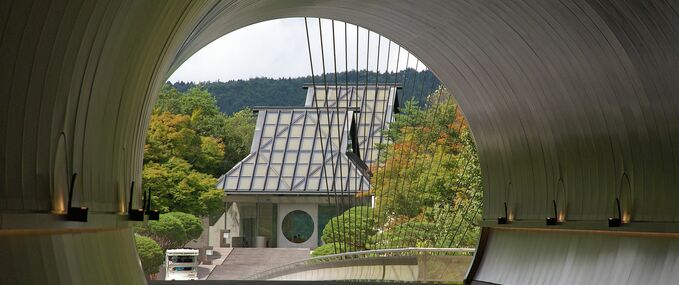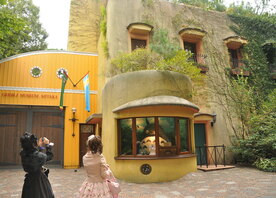With the Miho Museum you can witness ancient art and antiquities from Japan and the West inside a world class architectural landmark. 
Fans of art and architecture won’t want to miss the incredible Miho Museum when visiting Kyoto or Osaka. This fascinating museum found near the city of Kōka in Shiga Prefecture is home to thousands of ancient artworks and antiquities, set inside a brilliant building designed by internationally renowned architect I.M. Pei. As such, a visit to the Miho Museum is more than just about its collections but also the experience created by its world-class architecture.
Here’s everything you need to know to visit the Miho Museum when you travel around Japan by train.
History of the Miho Museum
To appreciate why the Miho Museum is worth visiting, travellers need to know a little about the museum’s origins. The Miho Museum opened its doors in 1997, but its founder Mihoko Koyama actually spent more than 40 years accumulating its impressive collection of artwork. 
Koyama sought to promote joy, peace and beauty through art and assembled her collection of Japanese art, paintings/calligraphy, ceramics and lacquerware with that in mind. Today the museum boasts a collection of roughly 3,000 pieces of art and antiques with a strong focus on ancient civilizations, but especially Shinto and Buddhist art.
A large portion of these pieces were personally collected by Koyama herself, while many were acquired through collaboration with art dealer Noriyoshi Horiuchi. Some exhibit pieces gathered have little to no provenance, leading to discussions about pieces belonging to previously lost treasures.
A Brief Background to Shinji Shumeikai
What some visitors to the museum might not realise is that the Miho Museum also acts as the headquarters for the Shinji Shumeikai spiritual organization. The museum is naturally open to people of all faiths, but it helps to understand this spiritual connection to appreciate the philosophy behind the museum.
Mihoko Koyama founded this religious group, Shinji Shumeikai or simply Shumei, in 1970 off the teachings of spiritualist Mokichi Okada. The location of the museum in Shiga Prefecture was deliberately chosen to ensure it was close to the Shumei temple among the Shiga mountains.
The philosophy of Shumei is not all that different from the beliefs that drove Koyama to start her collection of art. Shumei promotes an appreciation of art, beauty, and nature, and the belief that spiritual healing can help foster peace and tolerance.
The Museum Architecture and I.M. Pei

For many, what makes the Miho Museum such a special place to visit is its incredible architectural design. The museum was designed by internationally recognised Chinese-American architect I.M. Pei, who designed other famous structures including the Louvre Museum in Paris.
Pei came up with a design for the museum that would integrate the natural surroundings of the museum into its build. He took inspiration from The Peach Blossom Spring, an ancient Chinese fable written by Tao Yuanming, and sought to create an idyllic utopia that he referred to as Shangri-La. The space switches between man-made and natural environments to create a sense of warmth and harmony, even though much of the museum is actually underground. Like the Louvre Pyramid, the use of natural light is fundamental to the architecture’s impact.
Information for Visiting the Miho Museum
- The museum is open daily from 10:00 am to 5:00 pm, with its last entry at 4:00 pm.
- Visitors will find the museum closed on Mondays, or the next business day when a national holiday falls on a Monday. It is often also closed when exhibits are changed over, so be sure to check the museum’s calendar.
- Admission to the museum costs 1,300 yen for adults and 1,000 yen for students, while younger children and those with disabilities may enter for free.
- It is a 500 metre walk from the museum reception to the actual museum building. However, there are electric shuttles that operate between the two points.
- Audio guides are available for the museum’s permanent and special exhibits, with a rental fee of 500 yen for one set of headphones and 600 yen for two.
- Photography is not allowed within the museum’s exhibit spaces, while shots for commercial purposes and use of tripods and drones is prohibited throughout.
Visiting the Miho Museum with the JR Pass
Travellers will find that the Miho Museum is a relatively easy place to visit when travelling around Japan with their JR Pass. To get to the museum, travel from Kyoto Station to Ishiyama Station on the JR Tokaido Line. From there, you will need to buy a ticket for the Teisan bus number 150 that brings you to the museum.




